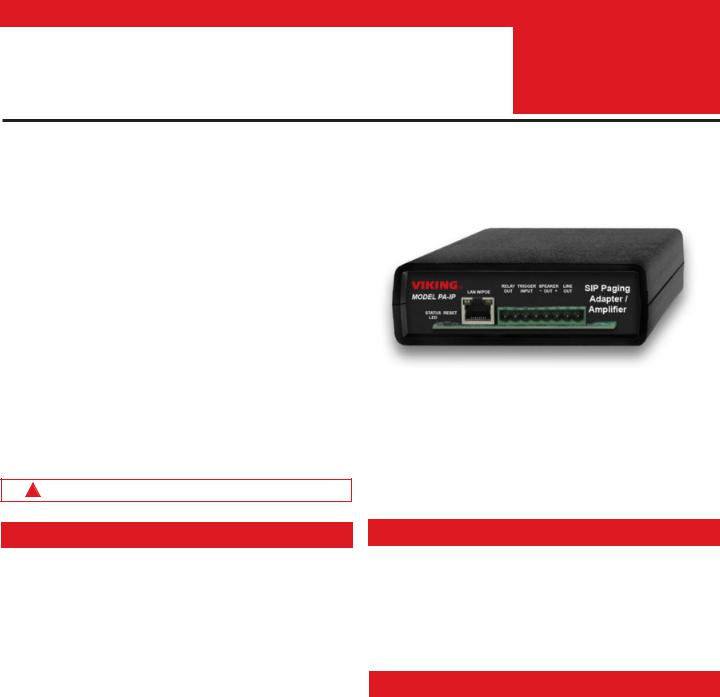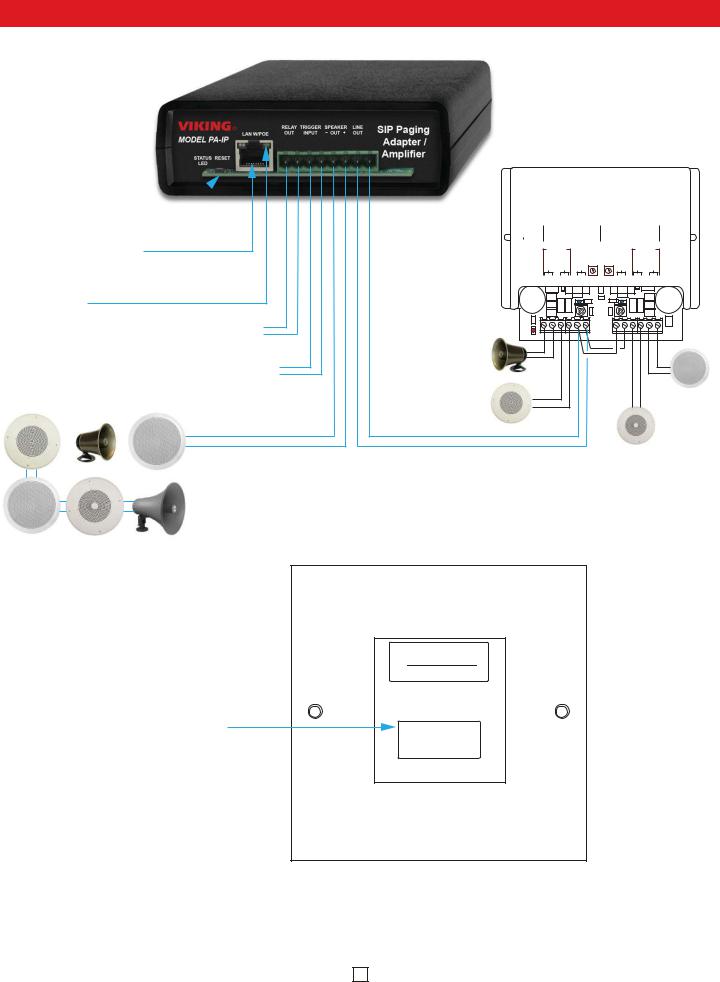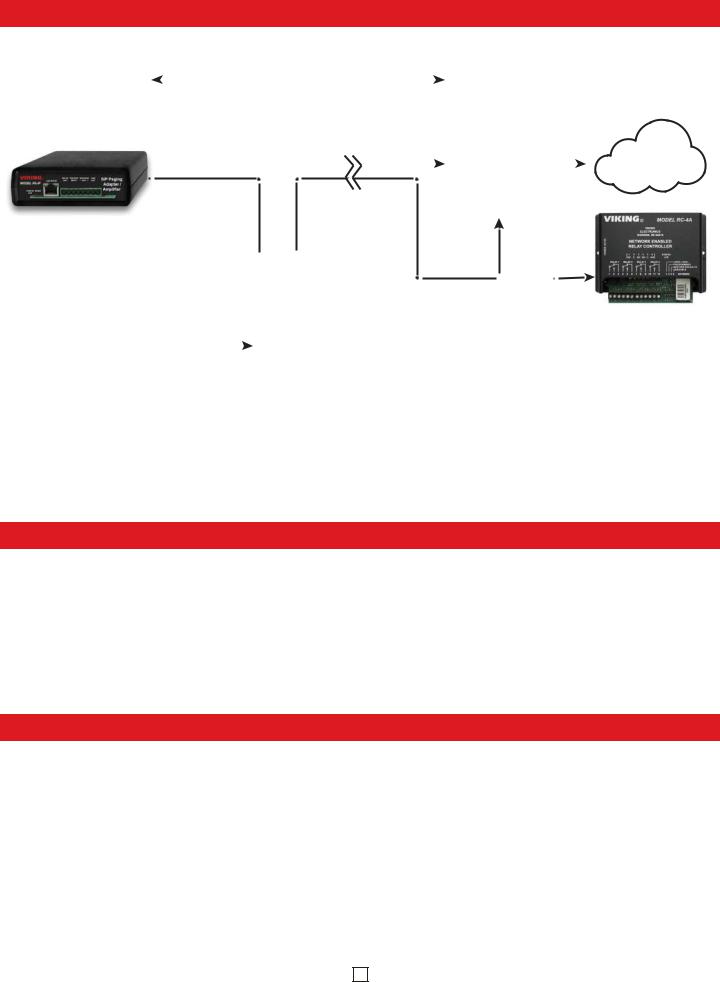Viking PA-IP User Manual

Designed, Manufactured and Supported in the USA |
PA-IP |
|
VIKINGPRODUCTMANUAL |
||
Adapter with Amplifier |
||
|
SIP / Multicast Paging |
SECURITY & COMMUNICATION SOLUTIONS
July 16, 2019
PoEPoweredVoIPEndpointInterfacesAnalogPaging
SystemswithSIPandMulticastPagingSources
The Viking model PA-IP SIP / Multicast Paging Adapter provides an interface between new VoIP phone systems (hardware or hosted/cloud based) and analog paging systems, eliminating the need for an ATA or FXS port. The PA-IP can be used for standard SIP endpoint paging or multicast paging and multicast background music.
The unit easily connects with a single CAT5/6 cable from your PoE switch. The night ring feature is programmable for time of day and day of week to enable loud ringing for after hour incoming calls. Alternatively the night ring feature can be enabled by a contact closure across the trigger input terminals. Line-level audio output connections are provided for connecting to an external amplifier.
!Installation requires a Network Administrator / IT Technician
A built-in 6 Watt class D amplifier with speaker output connections are also provided to drive up to six analog speakers. A programmable relay output is provided for triggering external amplifiers, etc.
Features
•SIP compliant (See page two for list of compatible SIP servers and IP phone systems)
•PoE powered (class 3, <13 Watts)
•Paging prioritization
•Plays audio from multicast
•SIP endpoint or multicast group member
•Supports up to ten multicast paging groups
•Red “Page/Status” LED indicator
•Network downloadable firmware
•Built-in high efficiency 6 Watt class D amplifier
•Can drive up to 6 external analog speakers
•Relay for activating door locks, strobe lights, external amplifiers, etc.
•SIP/Multicast: SIP page, SIP page and zoned multicast receive
•Support for access code to prevent unwanted SIP calls
•Line-level audio output for connecting to an external amplifier
•Network remote volume control
•Diagnostics (for testing the relay)
•Programmable pre page alert tone
Applications
•Amplified SIP endpoint or multicast IP paging for: schools, hospitals, retail stores, office spaces, etc.
•Provide multicast background music and sound masking
•IP phone system integration with traditional analog amplifier (e.g. single zone voice paging)
Specifications
Power: PoE class 3 (<13 Watts)
Dimensions: 5” x 5.25” x 1.5” (127mm x 133mm x 38mm)
Shipping Weight: 1.0 lbs (0.45 kg)
Operating Temperature: -40°F to 140°F (-40° C to 60° C) Humidity: 5% to 95% non-condensing
Audio Codecs: G711u, G722* and G711a*
Network Compliance: IEEE 802.3 af PoE, SIP 2.0 RFC3261, 100BASE-TX with auto cross over
Regulatory Compliance: CE, FCC Part 15 and Canada ICES-003 Class A Frequency Response: 55 – 18,000 Hz (+/- 10 dB)
Connections: (1) RJ45 10/100 Base-T, (1) 8 position terminal block
Amplifier: 6 Watt Class D (capable of driving up to six 8 Ohm speakers connected in parallel)
Maximum Output Level driving one Viking Model 40AE Ceiling Speaker: 105 dB SPL @ 1M
www.VikingElectronics.com |
*NOTE:The PA-IPdoes not support multicast paging using the G722 or G711a Codec. |

Viking VoIPSIPSystem Compatibility List
Note: Exclusionfromthislistmeansonlythatcompatibilityhasnotbeenverified,itdoesnotmeanincompatibility.
On-Premise
3COM VCX
3CX
Allworx*
Aastra
Asterisk
Atcom
AvayaAura Platform
Avaya IPOffice Platform
BlueBox
Brekeke
Cisco Unified Communications Manager (CUCM)*
Cisco Unified Communications Manager Express (CUCME)
Elastix
epygi QX200*
Freeswitch
Grandstream*
Interactive Intelligence
iPECS (Ericsson-LG)*
Iwatsu ECS*
Kamailio
Mitel 3300
NEC
OfficeSIP
OpenSIPS
Panasonic** (with SIPExtension Card)
PolyCom (SIPpaging only)
Samsung Communications Manager (SCM)
ShoreTel*
Siemens Communications Server (SCS)
SIPExpress Router (SER)
Snom PBX
Sonus
Switchvox
Teksip
Toshiba
Vertical Wave*
Yealink T Series SIPPhones
Cloud Based Service Provider
Callcentric*
iptel.org
MetaSwitch
Ring Central
sip.antisip.com
Switchvox
unify
Vertical Wave*
Voice Carrier
VoIP.MS*
* Note: For vendor specific detailed configuration instructions, see Configuring Viking VoIP Phone and SIP Servers,DOD944.
** Note: Relay operation commands are Not compatible with Panasonic Phone Systems (Panasonic does not transmitDTMFbetweenstationports).
2

Definitions
Client: Acomputer or device that makes use of a server. As an example, the client might request a particular file from the server.
DHCP: Dynamic Host Configuration Protocol. In this procedure the network server or router takes note of a client’s MAC address and assigns an IP address to allow the client to communicate with other devices on the network.
DNS Server: ADNS (Domain Name System) server translates domain names (ie: www.vikingelectronics.com) into an IP address.
Ethernet: Ethernet is the most commonly used LAN technology. An Ethernet Local Area Network typically uses twisted pair wires to achieve transmission speeds up to 1Gbps.
Host: Acomputer or device connected to a network.
Host Name: Ahost name is a label assigned to a device connected to a computer network that is used to identify the device in various forms of network communication.
HostsFile: AfilestoredinacomputerthatlistshostnamesandtheircorrespondingIPaddresseswiththepurposeofmappingaddresses to hosts or vice versa.
Internet: Aworldwide system of computer networks running on IPprotocol which can be accessed by individual computers or networks.
IP: Internet Protocol is the set of communications conventions that govern the way computers communicate on networks and on the Internet.
IPAddress: This is the address that uniquely identifies a host on a network.
LAN: LocalArea Network. ALAN is a network connecting computers and other devices within an office or building.
Lease: The amount of time a DHCP server reserves an address it has assigned. If the address isn’t used by the host for a period of time, the lease can expire and the address can be assigned to another host.
MACAddress: MACstandsforMediaAccessControl. AMACaddress,alsocalledahardwareaddressorphysicaladdress,isaunique address assigned to a device at the factory. It resides in the device’s memory and is used by network equipment to send data packets to the correct IP address. You can find the MAC address of your PA-IP page adapter printed on a white label on the bottom side of the chassis.
Router: A device that forwards data from one network to another. In order to send information to the right location, routers look at IP Address, MACAddress and Subnet Mask.
RTP:Real-TimeTransportProtocolisanInternetprotocolstandardthatspecifiesawayforprogramstomanagethereal-timetransmission of multimedia data over either unicast or multicast network services.
Server: Acomputer or device that fulfills requests from a client. This could involve the server sending a particular file requested by the client.
SessionInitiationProtocol(SIP):Isasignalingcommunicationsprotocol,widelyusedforcontrollingmultimediacommunicationsessions such as voice and video calls over Internet Protocol (IP) networks. The protocol defines the messages that are sent between endpoints, which govern establishment, termination and other essential elements of a call.
StaticIPAddress: AstaticIPAddresshasbeenassignedmanuallyandispermanentuntilitismanuallyremoved.Itisnotsubjecttothe Lease limitations of a Dynamic IPAddress assigned by the DHCP Server. The default static IPAddress is: 192.168.154.1
Subnet: A portion of a network that shares a common address component. On TCP/IP networks, subnets are defined as all devices whose IP addresses have the same prefix. For example, all devices with IP addresses that start with 100.100.100. would be part of the samesubnet.Dividinganetworkintosubnetsisusefulforbothsecurityandperformancereasons.IPnetworksaredividedusingasubnet mask.
TCP/IP:Transmission Control Protocol/Internet Protocol is the suite of communications protocols used to connect hosts on the Internet. TCP/IP uses several protocols, the two main ones being TCP and IP. TCP/IP is built into the UNIX operating system and is used by the Internet, making it the de facto standard for transmitting data over networks.
TISP: Telephone Internet Service Provider
WAN: Wide Area Network. A WAN is a network comprising a large geographical area like a state or country. The largest WAN is the Internet.
WirelessAccessPoint(AP): Adevice that allows wireless devices to connect to a wired network using Wi-Fi, or related standards.The
APusually connects to a router (via a wired network) as a standalone device, but it can also be an integral component of the router itself.
Wireless Repeater (Wireless Range Extender): takes an existing signal from a wireless router or access point and rebroadcasts it to createasecondnetwork.WhentwoormorehostshavetobeconnectedwithoneanotherovertheIEEE802.11protocolandthedistance is too long for a direct connection to be established, a wireless repeater is used to bridge the gap.
3

Features Overview
Green Unit Status LED 
Red Page / Status LED 
Reset Button 
PoE LAN Port 10/100, PoE Class 3 (<13 Watts):
Connect to your LAN via RJ45 plug and CAT5 or greater twisted pair wire.
Yellow Network Status LED: Lights steady to indicate power and data link. Blinks to indicate network activity.
Relay Output Contact (2A@30VDC / 250VAC max):
Connect to trigger input of amplifier, etc.
Switch or Contact Input: To Enable Night Ring Feature
30AE |
|
|
|
|
40AE |
|
|
|
|
25AE |
_ |
||
|
|
|
|
|
Speaker Out |
|
|
|
|
|
|
|
|
|
|
|
|
|
|
|
+
40AE 35AE 300AE
|
Optional Paging Amplifier |
||||||||||||
|
Viking model PA-60 shown (DOD 493) |
||||||||||||
|
VIKING© |
|
MODEL PA-60 |
||||||||||
|
|
|
|
|
|
|
VIKING |
|
|
|
|
|
|
|
|
|
|
|
|
|
ELECTRONICS |
|
|
|
|
||
|
|
|
|
|
|
HUDSON, WI 54016 |
|
|
|
||||
|
|
|
|
|
|
60 WATT 2 ZONE |
|
|
|
||||
Line Out |
|
|
|
|
|
POWER AMPLIFIER |
|
|
|
||||
PWR 60 W +/ 24 VDC |
|
|
|
|
|
|
|
|
|
|
|
|
|
600 Ohm |
|
CHANNEL 1 |
CHANNEL 2 |
|
|||||||||
Paging |
70V OUT |
|
LINE LEVEL |
|
|
LINE LEVEL |
AUDIO INPUT |
|
70V OUT |
||||
|
|
|
|
|
|
|
|
|
|||||
Audio |
SPKRS |
|
SPKRS |
|
GAIN |
GAIN |
|
SPKRS |
SPKRS |
||||
|
|
INPUTAUDIO |
|
|
|||||||||
|
PWR |
1 |
2 |
3 |
4 |
5 |
6 |
|
7 |
8 |
9 |
10 11 12 |
|
|
LED |
|
|||||||||||
Up to (15) |
|
|
|
|
|
|
|
|
|
|
|
|
|
8 Ohm Speakers |
|
|
|
|
|
|
|
|
|
|
|
|
|
(25AE shown, |
|
|
|
|
|
|
|
|
|
|
|
|
|
not included) |
|
|
|
|
|
|
|
|
|
|
|
|
|
Up to (15) |
|
|
|
|
|
|
|
|
|
|
|
|
Up to (15) |
8 Ohm Speakers |
|
|
|
|
|
|
|
|
|
|
|
|
|
|
|
|
|
|
|
|
|
|
|
|
|
8 Ohm Speakers |
|
(30AE shown, |
|
|
|
|
|
|
|
|
|
|
|
|
|
|
|
|
|
|
|
|
|
|
|
|
|
(40AE shown, |
|
not included) |
|
|
|
|
|
|
|
|
|
|
|
|
|
|
|
|
|
|
|
|
|
|
|
|
|
not included) |
|
|
|
|
|
|
|
|
|
|
|
|
|
|
|
|
|
|
|
|
|
|
|
|
Up to (15) |
||||
|
|
|
|
|
|
|
|
8 Ohm Speakers |
|||||
|
|
|
|
|
|
|
|
(35AE shown, |
|||||
|
|
|
|
|
|
|
|
not included) |
|||||
Bottom View
Up tp (6) Optional Viking Analog Speakers, see DOD 497 and 498
(not Included)
MAC Address Label:
The MAC address is a unique 12 digit number used by network equipment to send data packets to the correct IP address.
VIKING |
Model: xxxxxx |
|
S/N: XXXXXXXX |
|
|
P/N: xxxxxxxx |
DEV: |
|
Viking Electronics, Inc. (715) 386-8861 |
||
1531 Industrial St., Hudson, WI 54016 |
||
www.vikingelectronics.com DOD# |
||
|
MAC: 18E80FXXXXXX |
|
4

Typical Installation on SIPBased VoIPPhone System
|
|
|
|
100m (328 ft) maximum* |
|
|
|
|
|
|||
Viking |
|
|
|
|
|
|
|
|
|
|
|
|
|
|
|
|
|
|
|
|
|
|
|
||
|
|
|
|
|
|
|
|
|
|
|
||
|
|
|
10/100 Mbps |
|
|
SIP VoIP PBX |
|
|
||||
PA-IP |
|
|
|
|
|
|
|
|||||
|
|
|
|
|
Maximum |
|
|
or |
|
Internet |
||
|
|
|
|
|
|
|
|
|
|
PC with |
|
|
|
|
|
|
|
|
|
|
|
|
|
||
|
|
|
|
|
|
|
|
|
|
|
|
|
|
|
|
|
|
|
|
|
|
|
SIP Server |
|
|
|
|
|
|
|
|
|
|
|
|
Software |
|
|
|
|
|
|
|
|
Optional |
|
|
|
|
|
|
|
|
|
|
|
|
|
||||||
|
|
|
|
|
|
|
|
|
||||
|
|
|
|
|
PoE Injector |
|
|
|
|
|
|
|
|
|
|
|
|
(If VoIP PBX does |
|
|
|
|
|
|
|
|
|
|
|
|
|
|
|
**Optional |
|
|
||
|
|
|
|
|
not have PoE) |
|
|
|
|
|
||
|
|
|
|
|
|
|
|
|
|
Switch / Hub |
|
|
Viking |
|
|
|
Customer’s |
|
|
|
|||||
|
|
|
|
|
|
|
|
|||||
|
|
|
(Extends range of cable, keeps |
Optional Viking model RC-4A |
||||||||
supplies |
|
Responsibility |
||||||||||
|
1 Gbps network speed for other |
Secure Remote Relay |
||||||||||
|
|
|
|
|
|
|
|
|
equipment on network) |
Controller, see Programming |
||
|
|
|
|
|
|
|
|
|
|
|
|
section 12 (DOD 582) |
* Note: A PoE extender can be used for an additional 100 meters per extender. For longer runs (up to 2 km / 1.2 miles) a ethernet to fiber media converter can be used.
** Network Port Settings
•Make sure the port is not in trunk mode
•Make sure port is capable of 100mbps full duplex
•Disable Spanning Tree Protocol (STP) or enable Portfast
PC Requirements
•IBM compatible personal computer with: Windows 7, 8 or 10
•AdobeAcrobat Reader 8 or higher
•PA-IP hardware
•Available LAN with PoE (class 3, <13 Watts)
•Ethernet cable (CAT5 minimum)
•1 MB minimum free hard drive space for installation
•16MB of free physical RAM
PC Programming
Download and install the programming software
1.Go to www.vikingelectronics.com and enter PA-IP in the search box
2.Click PA-IP in the search results
3.Scroll down the page to Downloads, click IPProgramming Software
4.Install the programming software by saving or opening the file and then clicking on setup Viking IP
Programming.exe
5.Follow the prompts on your screen to complete software installation
6.To start the Viking IP Programming application, click on the Viking IP Programming icon on your desk top. The Main screen will appear, allowing the user to program any PA-IP connected to that LAN.
Note: PCmustbeconnectedtothesameLANasthePA-IP.
5

A. Connect/Disconnect
Open the “Viking IP Programming” software on the PC and the start screen shown below will appear. Any Viking IP products that are connected to the network will appear on the list. Simply select the PA-IP on the list and click on the “Connect” button at the bottom or double click the selected unit. If no username and password have been programmed and the security code of the selected unit is still set to default (845464), the PC software will not require entering a username, password or security code to connect to the PA-IP. If the PA-IP has been programmed with a username and password, a pop up window will ask for the username followed by the password. If the unit’s security code has been changed from “845464”, it will then prompt for the correct security code. PA-IP’s have a default name of “uCMK64_40TB-IP”, so if many PA-IP’s are connected to the same network and all have the default name, MAC addresses must be used to identify each PA-IP. When finished programming, click on the “Disconnect” button at the bottom. Closing the program will also automatically disconnect the unit.
B. Configuring the PA-IPNetwork Settings
Open the “Viking IP Programming” software on a windows PC that is connected to the same LAN as the PA-IP speaker to be Step 1. programmed.
The window in the upper left corner of the menu will show you each PA-IP that is connected to that LAN. Select the unit with the same Step 2. MAC address shown on the label located on the top of the Ethernet connector on the PA-IP or the matching label that can be found on
the bottom of the Black Box.
Click on the “connect” button. Adefault PA-IP has no username or password programmed, the security code is set to “845464” and
when configured this way, you are instantly connected to the PA-IP. If the PA-IP has been programmed with a username and Step 3. password, a pop up window will ask for the username followed by the password. If the unit’s security code has been changed from
“845464”, it will then prompt for the correct security code, then click “retry”.
Step 4. The program will then read and display the PA-IP’s IP and programming settings.
Step 5. Click on the “IP Settings” tab.
Step 6. Select the appropriate value Static IP Settings or DHCP for “Set Unit IPAddress via”. Note: Changing the IPaddress will cause you to havetoreconnecttotheunit. Enterthevaluesforthefieldsin“ifDHCPfails”or“StaticIPSettings”asneeded.
Step 7. Set the “Unit Name”, “Logging / Time Server Settings” as needed.
Select Peer-Peer in the “SIP Server / Peer to Peer Settings” to use the unit in Peer to Peer mode or for Multicast paging only. Select Server to register with a SIPregistrar server and fill in the “Outbnd Proxy” (SIPOutbound Proxy ServerAddress, “ip:port”), “Authentic. ID” Step 8. (SIPAuthentication ID), “Username” (SIP Username, <string>), “Password” (SIP Password), and “Caller ID” (SIP Caller ID) with values
from your VoIP provider. Required fields will be red when the unit is not registered.
6
